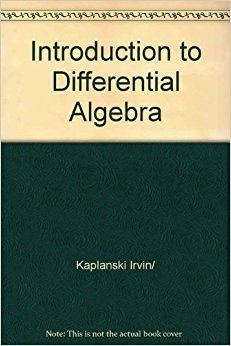 | ||
In mathematics, differential rings, differential fields, and differential algebras are rings, fields, and algebras equipped with finitely many derivations, which are unary functions that are linear and satisfy the Leibniz product rule. A natural example of a differential field is the field of rational functions C(t) in one variable, over the complex numbers, where the derivation is the differentiation with respect to t.
Contents
- Differential ring
- Differential field
- Derivation on a Lie algebra
- Examples
- Ring of pseudo differential operators
- References
Differential algebra refers also to the area of mathematics consisting in the study of these algebraic objects and their use for an algebraic study of the differential equations. Differential algebra was introduced by Joseph Ritt.
Differential ring
A differential ring is a ring R equipped with one or more derivations, that are homomorphisms of additive groups
such that each derivation ∂ satisfies the Leibniz product rule
for every
where
Differential field
A differential field is a commutative field K equipped with derivations.
The well-known formula for differentiating fractions
follows from the product rule. Indeed, we must have
By the product rule, we then have
Solving with respect to
If K is a differential field then the field of constants of K is
A differential algebra over a field K is a K-algebra A wherein the derivation(s) commutes with the field. That is, for all
In index-free notation, if
As above, the derivation must obey the Leibniz rule over the algebra multiplication, and must be linear over addition. Thus, for all
and
Derivation on a Lie algebra
A derivation on a Lie algebra
For any
Examples
If
Any ring is a differential ring with respect to the trivial derivation which maps any ring element to zero.
The field Q(t) has a unique structure as a differential field, determined by setting ∂(t) = 1: the field axioms along with the axioms for derivations ensure that the derivation is differentiation with respect to t. For example, by commutativity of multiplication and the Leibniz law one has that ∂(u2) = u ∂(u) + ∂(u)u= 2u∂(u).
The differential field Q(t) fails to have a solution to the differential equation
but expands to a larger differential field including the function et which does have a solution to this equation. A differential field with solutions to all systems of differential equations is called a differentially closed field. Such fields exist, although they do not appear as natural algebraic or geometric objects. All differential fields (of bounded cardinality) embed into a large differentially closed field. Differential fields are the objects of study in differential Galois theory.
Naturally occurring examples of derivations are partial derivatives, Lie derivatives, the Pincherle derivative, and the commutator with respect to an element of an algebra.
Ring of pseudo-differential operators
Differential rings and differential algebras are often studied by means of the ring of pseudo-differential operators on them.
This is the ring
Multiplication on this ring is defined as
Here
which makes use of the identity
and
